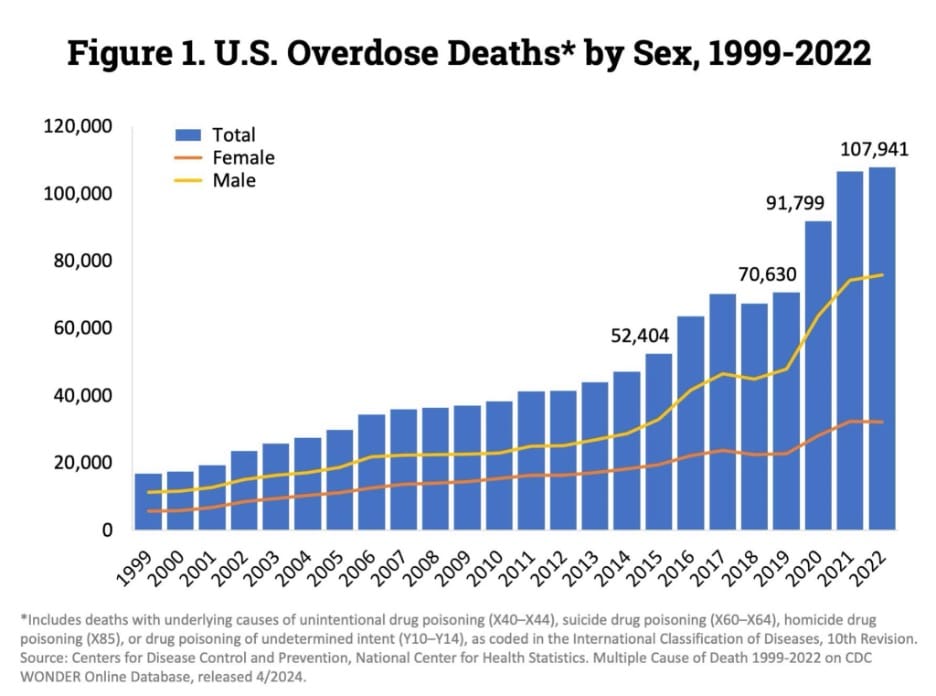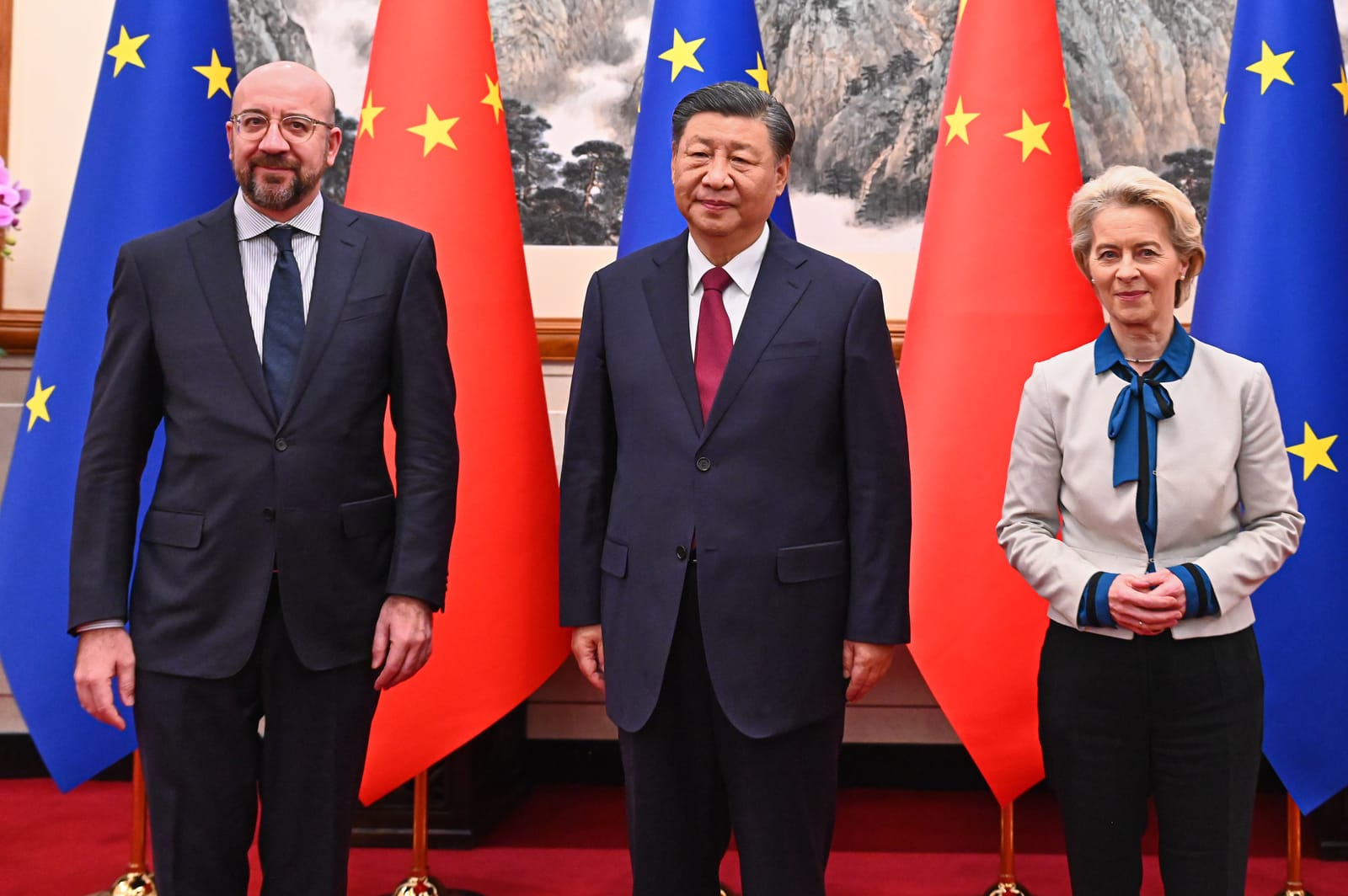This analysis affirms that the deployment of narcotics—particularly synthetic opioids—as a tool of strategic subversion is not merely criminal; it is a form of warfare conducted in slow motion. China does not differentiate between peace and war.[1] The American fentanyl epidemic is not accidental but actively funded, supported, and driven by the Chinese Communist Party (CCP) in coalition with Mexican drug cartels. The lethality of these substances has proven exponentially more damaging than traditional military campaigns.
In 2019, the Department of Homeland Security considered designating fentanyl a weapon of mass destruction.[2] The categorization “Illicit Fentanyl” was introduced to Congress on March 3rd 2025.[3] The assessment highlights the level of destruction this substance has caused. In 2019, China was the largest producer of fentanyl and its precursors.[4] Thereafter, Mexico has replaced China as the primary fentanyl producer, but the chemical precursors derive from China.[5]
Exploiting the Human Legacy of Addiction
While it is true that companies such as Purdue Pharma and other American unscrupulous stakeholders fueled a major opioid addiction in the US with oxycontin, China has now replaced and surpassed the American pharmaceutical industry altogether.[6] Nevertheless, did the American pharmaceutical industry provide the market for the ongoing fentanyl crisis? Not necessarily. Despite not experiencing an industry-caused addiction similar to the USA, some countries in Europe have also been hit hard by Chinese fentanyl.[7] It would therefore stand to reason that fentanyl will cause mayhem wherever pushed. It is not a question of whether there is a market, but whether there is a product with access to a populated area. China experienced the devastating effects of drugs in the nineteenth century.[8] They understand the ramifications drugs create, and the Chinese Communist Party has therefore weaponized drugs against the West.

Fentanyl has created a wave of societal turmoil the USA has never seen. In 2023 more than 107,000 Americans lost their lives to drug overdoses, of which more than two thirds were opioid or fentanyl related.[9] The annual deaths in the U.S. stemming from the use of fentanyl have by far exceeded the total number of American lives lost throughout the Vietnam War. Furthermore, the deaths have contributed to lowering life expectancy by nearly a year in the U.S.[10] American statistics seem unfathomable to Europe–leaving the continent paralyzed, oblivious, and either unable or unwilling to act.[11] At what threshold of societal death is it reasonable to expect political action? First and foremost, it would be prudent to define the nature of fentanyl.
Fentanyl: Pharmacology and Historical Development
Fentanyl was first synthesized in 1959 by Dr. Paul Janssen of Janssen Pharmaceutica. Its development was part of a systematic effort to create potent analgesics by modifying the chemical structure of meperidine (also known as pethidine or Demerol), a synthetic opioid introduced in the 1930s.[12]
Fentanyl is a synthetic opioid, meaning it is a man-made substance that mimics the effects of naturally occurring opioids by binding and subsequent activation of a class A G protein-coupled receptor (GPCR) μ-opioid receptor (mOR) in the brain and spinal cord to reduce pain perception.[13] Unlike opium, which is directly derived from the poppy plant and contains natural alkaloids like morphine and codeine, fentanyl is fully synthetic and not derived from opium itself. It is approximately 50 to 100 times more potent than morphine.[14],[15] This potency stems from fentanyl’s high lipid solubility, allowing it to rapidly cross the blood-brain barrier and produce intense effects within minutes.[16] As a result, even tiny amounts can induce profound analgesia or fatal respiratory depression, especially when used outside of clinical supervision. These properties made it particularly suitable for use as an intravenous anesthetic in surgical settings.[17]

Over time, various formulations of fentanyl were developed, including oral transmucosal lozenges, commonly referred to as the fentanyl 'lollipops' (Actiq®), effervescent buccal tablets (Fentora™), sublingual tablets (Abstral®), sublingual sprays (Subsys™), nasal sprays (Lazanda®), transdermal patches (Duragesic®), and injectable formulations.[18] All these formulations have expanded fentanyl´s medical applications.[19] However, its high potency and multivarious forms have also contributed to its potential for misuse and overdose, especially when diverted from medical use or synthesized. This evolution underscores the importance of distinguishing fentanyl from traditional opium derivatives, as its synthetic nature makes it easier to manufacture in clandestine labs and harder to regulate or detect in global trafficking networks.
Not only a Malicious Act of Warfare, but Intrinsically Evil
If one were to seek a moral and symbolic analogue, the use of narcotics as instruments of war would be akin to Dante’s Inferno. Particularly relevant are the Eighth and Ninth Circles of Hell, where the gravest sins of intellect and betrayal reside.[20] In Dante’s moral architecture, fraud is the deliberate manipulation of another’s mind or trust and is considered more awful than brute violence. The Eighth Circle is reserved for those who weaponize intellect and language: deceivers, false counselors, and hypocrites. In this sense, the modern machinery of psychological manipulation and biochemical control finds a prophetic echo in Dante’s medieval vision–a hell built not only for tyrants, but for the engineers of despair.
China’s attack on Western willpower has surgical precision. By employing legal means by developing smartphone apps to corrupt youth with algorithms designed to sow self hatred and division in the West, while encouraging their own population by promotion of positive or inspirational encouraging messages.[21] This, combined with fentanyl’s destabilizing effect, is a perversion of the Roman concept of bread and circus, twisting Western values through apps, and poisoning populations with narcotics. This is not a coincidence or flaw, it is by strategic design and intrinsically evil since the Western mind regards children, youth and civilians as “off limits”. While in the communist lens, they are a primary target.
Historical Context
The use of narcotics in warfare is etched within the confines of Chinese heritage. In the seventeenth century, the British East India Company established a powerful commercial infrastructure across colonial India, including the systematic cultivation of opium. By the late eighteenth and early nineteenth centuries, opium became a primary export to China. Silver drained from Chinese coffers while dependency spread, even within governmental and military ranks. British economic interests increasingly aligned with the perpetuation that addiction created leverage. One British trader dryly noted, “No time to read my Bible,” reflecting the trade’s scale and singular focus. In 1839, the Chinese authorities were seeking to reassert control. They seized and destroyed British opium stores. London reacted by military force. The First Opium War (1839–1842) ended in China’s defeat and the imposition of indemnities and unequal treaties. Though the term opium was conspicuously absent from the resulting diplomatic texts, the substance itself was at the core.[22]
In 1859, as tensions over treaty interpretations escalated, Anglo-French forces launched an expedition against Beijing. This resulted in the destruction and looting of the imperial Summer Palace. These military engagements were not merely episodes of nineteenth-century imperial conflict—they inflicted profound psychological and political trauma on China. The legacy of what Chinese historiography terms the “Century of Humiliation” continues to inform strategic culture and foreign strategy. Suspicion of Western intentions, particularly those of former colonial powers, remains deeply rooted in China’s national narrative.[23]
American State of Affairs
In 2016, the American opioid crisis was so dire that it prompted a group of health experts to beg the Obama-administration for action.[24] This fell on deaf ears. Instead, Obama declared the Zika Virus, claiming two American lives, a national health emergency.[25] President Obama left the White House with the worst drug crisis in U.S. history.
The new administration finally recognized the crisis in 2017. The 45th President declared the opioid crisis a national health emergency.[26] The rise in overdose deaths seen under Obama started to level off, and remained stable through the 45th presidency until 2020 where it peaked. It skyrocketed during the Biden era.[27] During the first 100 days of the current U.S. presidency, law authorities have seized 3400 kilos of fentanyl.[28] Critics assert that the U.S. Attorney General's claim that the seizure has saved up to 258 million lives was likely exaggerated.[29] In a bipartisan perspective, it seems plausible that the AG merely suggested the theoretical potential deaths that amount of fentanyl could have caused, had it not been seized.

The current administration has attempted to tackle the deadly flow of fentanyl by imposing severe duties on China.[30] Trump achieved some success in a similar regard during his last presidency by pressuring China to attribute fentanyl-related substances to controlled drugs.[31] Regrettably, such countermeasures are short sighted. Meanwhile, China is likely to direct its deadly poison more heavily into Europe. Why not address the evident 800-pound gorilla, once totalitarian regimes are invited into the global community, that community is jeopardized. If there is in any doubt to whether China is undermining the West, one only needs to read the United States House Select Committee on Strategic Competition between the United States and the Chinese Communist Party report, “CCP General Secretary Xi Jinping has stated that the PRC’s ´ideology and social system are fundamentally incompatible with the West´ and that it is the role of the PRC government to lead the construction of a “new world order [. . .] that will supplant the [liberal democratic] Westphalian system”.[32]
Europe's Failure to Come to Terms with Communism - Rendering the Continent Especially Susceptible to Stealth Warfare
Despite similarities and indirect cooperation against British imperialism, the American and French revolutions differ in one crucial respect. Whereas the US Constitution is based on individual freedom, the French Revolution created the breeding ground for Bolshevism in Europe by cultivating a mentality of collectivism.[33] This created a misconceived sphere that makes Europe particularly susceptible to totalitarian thinking. This mindset was seen in politicians such as Joschka Fischer who supported the Baader-Meinhof gang.[34] Even to this day there are communist parties represented in Western European parliaments. This severely influences political thinking and degrades free will and speech. It creates a consensus-driven society where any views contradicting the narrative are perceived as radical. In Europe McCarthyism is frowned upon, and was understood as a witch-hunt despite the fact that the ideology it persecuted delivered the greatest genocide in history.[35] Fentanyl has created a novel and chemically engineered massacre.
The vulnerability is not exclusively a historical or philosophical predicament as exemplified in Dante's Inferno. It has direct consequences for how Europe (and, by extension, the West) perceives and responds to hostile acts disguised as non-military. The collective mentality inherited from post-revolutionary thought, amplified by the 1968 generation, has created a political and academic climate where conflict is often viewed through a moral-relativist or bureaucratic lens. As a result, modern forms of aggression that do not rely on tanks or missiles, but on synthetic opioids, digital manipulation, and economic leverage, are frequently dismissed as peripheral issues.
Carl von Clausewitz offers a useful lens for understanding why Western strategic thinkers have shown limited engagement with China’s stealth-based form of warfare. In fact, his reflections on the stagnation of war and the absence of psychological momentum align closely with the hypothesis previously raised: that China’s methods are perceived by Western scholars as too mundane to merit serious analytical attention.[36] Firstly, Clausewitz notes that when a belligerent lacks not only resources, but also the psychological impulse to escalate, the war begins to stagnate.[37] Conventional warfare commands attention through kinetic force and visible escalation. For scholars trained to view war as a high-intensity clash of arms, the absence of emotional and visual impact renders the Chinese approach uninviting. Secondly, Clausewitz describes a phase where war is prosecuted so weakly that it consists merely of “threats against the enemy combined with negotiations behind the scenes”.[38] To the Western strategic mind (or lack thereof), this form of conflict is decentralized, legalistic, and often bureaucratic. Its mundanity is precisely what allows it to persist, unchallenged.
Lastly, Clausewitz warns that when war becomes increasingly passive and subject to moderating forces, its conceptual essence begins to erode.[39] This reflects the West’s analytical paralysis: the failure to recognize China’s actions as warfare stems not from ignorance but from a conceptual framework, ill-equipped to process non-military instruments of power. Scholars and policymakers alike overlook stealth warfare. Not because it is invisible, but because it is ignored or intellectually misclassified as something other than war. The reality is more concerning: that Western thinkers are subject to sloth by proxy (narrative driven), and therefore avoid matters without sufficient status or panache. Throwing a loud tantrum on the war in Ukraine contrasts the silence towards the sino threat. What the West perceives as non-threatening legalism or economic competition may, in fact, be the slow erosion of its own sovereignty—executed with deadly precision.
The Orient and Occident: Snapping the Companionship out of its Limerence
China utilizes the gestalt principle of “Common Fate”, where the West's expectation of a Chinese pattern of action that seemingly promotes Occidental interests often inhibits the political establishment from perceiving veiled individual actions of war. If the West continues to facilitate dependency and the ensuing poverty that follows, China will discreetly keep playing on this to create a large suffering mass desperately seeking resolution. It is the very attributes of such a mass that enables communism. Upon addressing the poverty and unenlightenment of China's population Mao Zedong stated, “...Poor people want change, want to do things, want a revolution. A clean sheet of paper has no blotches, and so the newest and most beautiful pictures can be painted on it”.[40] Societal collapse through Chinese warfare of peddling fentanyl is much more likely than political intervention. From the ashes, China will thrive.
The West is embedded with China. In fear of economic impact, this has chained the West to a hollow globalization project ignoring the Chinese distortion of perception. Globalization has merely become an apparatus for the depletion of natural resources and increased climate emissions.[41] The apparatus further grants China the structure for conducting covert warfare. Temporary recession, in this context “jonesing”, in a bid to save the planet and democracy is a small price to pay. The alternative only grants wealth for a few, and freedom for none in a contaminated lair of despair.
FOTNOTER
[1] Alf Einar Ulvund Johnsen and Georgian Lucian Røstad, “The Chinese Communist Party is Instigating Global Perpetual Havoc”, Stratagem, 15 Nov 2024, https://www.stratagem.no/the-chinese-communist-party-is-instigating-global-perpetual-havoc/
[2] Caitlin Owens, “DHS considers classifying fentanyl as a weapon of mass destruction”, Axios, 16 April 2019, https://www.axios.com/2019/04/16/fentanyl-dhs-weapon-of-mass-destruction
[3] H.R.128 – 119th Congress (2025-2026), Fentanyl is a WMD Act, H.R.128, 119th Cong., 2025, All Info - H.R.128 - 119th Congress (2025-2026): Fentanyl is a WMD Act | Congress.gov | Library of Congress
[4] “Fentanyl Flow to the United States”, Drug Enforcement Agency, January 2020, https://www.dea.gov/sites/default/files/2020-03/DEA_GOV_DIR-008-20%20Fentanyl%20Flow%20in%20the%20United%20States_0.pdf
[5] Liana W. Rosen and Claire Ribando Seelke, “Illicit Fentanyl and Mexico’s Role”, Congress, Foreign Affairs,19 December 2024, https://www.congress.gov/crs-product/IF10400#:~:text=At%20present%2C%20most%20U.S.%2Ddestined,from%20certain%20countries%2C%20including%20China.
[6] Justice Department Announces Global Resolution of Criminal and Civil Investigations with Opioid Manufacturer Purdue Pharma and Civil Settlement with Members of the Sackler Family, U.S. Department of Justice, Press Release, 21 October 2020, https://www.justice.gov/archives/opa/pr/justice-department-announces-global-resolution-criminal-and-civil-investigations-opioid
[7] Isabella Adinolfi, EU Parliament, 18 October 2023, https://www.europarl.europa.eu/doceo/document/E-9-2023-003085_EN.html
[8] Bennet Sherry, “Opium Wars and Economic Imperialism”, OER Project, https://www.oerproject.com/OER-Materials/OER-Media/HTML-Articles/Origins/Unit7/Opium-Wars-and-Economic-Imperialism/1200L
[9] “Overdose Deaths Decline, Fentanyl Threat Looms”, Drug Enforcement Agency, 16 December 2024, https://www.dea.gov/press-releases/2024/12/16/overdose-deaths-decline-fentanyl-threat-looms
[10] Catherine Graham, “Fatal Opioid Overdoses Lower U.S. Life Expectancy by Nearly a Year“, John Hopkins University, 30 July 2024, https://hub.jhu.edu/2024/07/30/opioid-overdoses-us-life-expectancy-decline/
[11] Daniel Brombacher and Rugerro Scaturro, “Highly potent synthetic opioids are already in Europe’s drug supply chains”, Global Initiative Against Organized Crime, 5. November 2024, https://globalinitiative.net/analysis/highly-potent-synthetic-opioids-are-already-in-europes-drug-supply-chains/
[12] Westhoff, B. (2019). Fentanyl, Inc.: How rogue chemists created the deadliest wave of the opioid epidemic. Atlantic Monthly Press.
[13] Pathan H.; Williams J. Basic Opioid Pharmacology: An Update. Br. J. Pain 2012, 6, 11–16.
[14] Comer, S. D., & Cahill, C. M. (2019). Fentanyl: Receptor pharmacology, abuse potential, and implications for treatment. Neuroscience & Biobehavioral Reviews.
[15] Kuczynska, K., Grzonkowski, P., Kacprzak, Ł., & Zawilska, J. B. (2023). Fentanyl. In StatPearls.
[16] Kelly, E. (2021). The anomalous pharmacology of fentanyl. British Journal of Pharmacology.
[17] Zawilska, J. B., & Kuczyńska, K. (2018). Fentanyl: A review of its history and current status. American Journal of Health-System Pharmacy.
[18] Drug Enforcement Agency, FENTANYL (Trade Names: Actiq®, FentoraTM, Duragesic®), December 2016, https://www.dea.gov/sites/default/files/drug_chem_info/fentanyl.pdf
[19] Armenian, P., Vo, K. T., Barr-Walker, J., & Lynch, K. L. (2018). Fentanyl, fentanyl analogs and novel synthetic opioids: A comprehensive review. Neuropharmacology.
[20] Alighieri, Dante. The Divine Comedy. New York, Barnes & Noble, Translated Henry Wadsworth Longfellow, 2016. p.190.
[21] Polly Thompson and Spria Srivastava, “TikTok is 'severely damaging' young people — unlike its Chinese equivalent, 'The Anxious Generation' author tells BI”, Business Insider, 24 January 2025, https://www.businessinsider.com/tiktok-different-china-douyin-jonathan-haidt-anxious-generation-national-2025-1
[22] Færøyvik, Torbjørn. Kina på 200 sider: fra de første dynastiene til dagens stormakt. 1 ed., Oslo, Kagge forlag, 2020. p.74-75.
[23] Ibid.
[24] Scott Higham, Sari Horwitz and Katie Zetima , “The Fentanyl Failure”, The Washington Post, 19 March 2019, https://www.washingtonpost.com/graphics/2019/national/fentanyl-epidemic-obama-administration/?utm_term=.390ecb4a2cd3
[25] Ibid.
[26] “Ending America’s Opioid Crisis”, National Archives, https://trumpwhitehouse.archives.gov/opioids/
[27] “Drug Overdose Deaths: Facts and Figures”, 2024, https://nida.nih.gov/research-topics/trends-statistics/overdose-death-rates#Fig1
[28] Ryan Bort, “Pam BondiI Flatters Trump with Claim that 75% OF America would be Dead if Not for Him”, RollingStone, 30 April 2025, https://www.rollingstone.com/politics/politics-news/pam-bondi-trump-saved-americans-fentanyl-death-1235328633
[29] Ibid.
[30] President, Presidential Action. “Imposing Duties to Address the Synthetic Opioid Supply Chain in the People’s Republic of China”, (Washington DC, 2025), https://www.whitehouse.gov/presidential-actions/2025/02/imposing-duties-to-address-the-synthetic-opioid-supply-chain-in-the-peoples-republic-of-china/
[31] Steven Jiang and Ben Westcott, “China announces new crackdown on fentanyl in win for US President Trump”, CNN, 1 April 2019, https://edition.cnn.com/2019/04/01/asia/china-us-fentanyl-trump-intl/index.html
[32] United States House of Representatives. Select Committee on Strategic Competition between the United States and the Chinese Communist Party, The CCP’S role in the Fentanyl Crisis, 35, https://selectcommitteeontheccp.house.gov/sites/evo-subsites/selectcommitteeontheccp.house.gov/files/evo-media-document/The%20CCP%27s%20Role%20in%20the%20Fentanyl%20Crisis%204.16.24%20%281%29.pdf
[33] Richard M. Ebeling, “Inflation, Price Controls, and Collectivism During the French Revolution”, Foundation for Economic Education, 9 November 2019, https://fee.org/articles/inflation-price-controls-and-collectivism-during-the-french-revolution/
[34] Quoted in Paul Berman, Power and the Idealists: or, The Passion of Joschka Fischer, and Its Aftermath, (New York, NY: W.W. Norton & Company Ltd.., 2007), 145
[35] Steven W. Mosher, The Devil and Communist China: From Mao Down to Xi, (North Carolina: Tan Books, 2024), 3
[36] Georgian Lucian Røstad, “Skjult krig mot Norge?”, Stratagem, 4 August 2023, https://www.stratagem.no/untitled/
[37] Carl von Clausewitz, Om krigen, Riga, Latvia, Vidarforlaget, 2020, 927
[38] Ibid.
[39] Ibid.
[40] Quoted in Steven W. Mosher, The Devil and Communist China: From Mao Down to Xi, 186
[41] Tim Stobierski , “4 Effects of Globalization on the Environment”, Harvard Business School, 15 April 2021, https://online.hbs.edu/blog/post/globalization-effects-on-environment
Photo: Wikimedia commons











